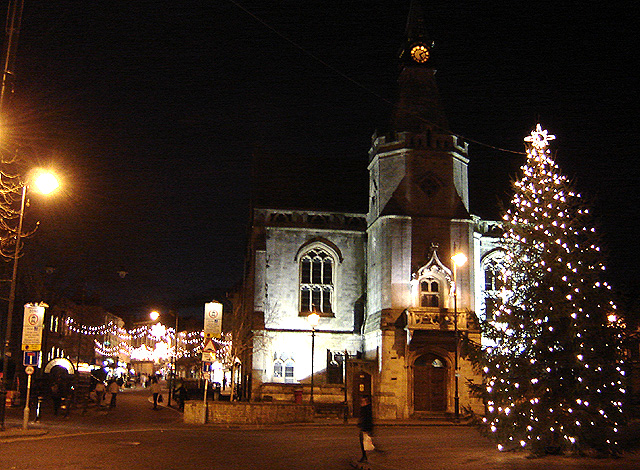|
Archdeacon Of Boston
The Diocese of Lincoln forms part of the Province of Canterbury in England. The present diocese covers the ceremonial county of Lincolnshire. History The diocese traces its roots in an unbroken line to the Pre-Reformation Diocese of Leicester, founded in 679. The see of Leicester was translated to Dorchester in the late 9th century, before taking in the territory of the Diocese of Lindsey and being translated to Lincoln. The diocese was then the largest in England, extending from the River Thames to the Humber Estuary. In 1072, Remigius de Fécamp, bishop under William the Conqueror, moved the see to Lincoln, although the Bishops of Lincoln retained significant landholdings within Oxfordshire. Because of this historic link, for a long time Banbury remained a peculiar of the Bishop of Lincoln. The modern diocese remains notoriously extensive, having been reportedly referred to by Bob Hardy, Bishop of Lincoln, as "2,000 square miles of bugger all" in 2002. The dio ... [...More Info...] [...Related Items...] OR: [Wikipedia] [Google] [Baidu] |
Province Of Canterbury
The Province of Canterbury, or less formally the Southern Province, is one of two ecclesiastical provinces which constitute the Church of England. The other is the Province of York (which consists of 12 dioceses). Overview The Province consists of 30 dioceses, covering roughly two-thirds of England, parts of Wales, all of the Channel Islands and continental Europe, Morocco, Turkey, Mongolia and the territory of the former Soviet Union (under the jurisdiction of the Diocese of Gibraltar in Europe). The Province previously also covered all of Wales but lost most of its jurisdiction in 1920, when the then four dioceses of the Church in Wales were disestablished and separated from Canterbury to form a distinct ecclesiastical province of the Anglican Communion. The Province of Canterbury retained jurisdiction over eighteen areas of Wales that were defined as part of "border parishes", parishes whose ecclesiastical boundaries straddled the temporal boundary between England and Wale ... [...More Info...] [...Related Items...] OR: [Wikipedia] [Google] [Baidu] |
Ceremonial Counties Of England
The counties and areas for the purposes of the lieutenancies, also referred to as the lieutenancy areas of England and informally known as ceremonial counties, are areas of England to which lords-lieutenant are appointed. Legally, the areas in England, as well as in Wales and Scotland, are defined by the Lieutenancies Act 1997 as "counties and areas for the purposes of the lieutenancies in Great Britain", in contrast to the areas used for local government. They are also informally known as "geographic counties", to distinguish them from other types of counties of England. History The distinction between a county for purposes of the lieutenancy and a county for administrative purposes is not a new one; in some cases, a county corporate that was part of a county appointed its own lieutenant (although the lieutenant of the containing county would often be appointed to this position, as well), and the three Ridings of Yorkshire had been treated as three counties for lieute ... [...More Info...] [...Related Items...] OR: [Wikipedia] [Google] [Baidu] |
Royal Peculiar
A royal peculiar is a Church of England parish or church exempt from the jurisdiction of the diocese and the province in which it lies, and subject to the direct jurisdiction of the monarch, or in Cornwall by the duke. Definition The church parish system dates from Saxon times when most early churches were provided by the lord whose estate land coincided with that of the parish. A donative parish (or "peculiar") was one that was exempt from diocesan jurisdiction. There are several reasons for peculiars but usually they were held by a senior churchman from another district, parish or diocese. They could include the separate or "peculiar" jurisdiction of the monarch, another archbishop or bishop, or the dean and chapter of a cathedral (also, the Knights Templar and the Knights Hospitaller). An ''archbishop's peculiar'' is subject to the direct jurisdiction of an archbishop and a ''royal peculiar'' is subject to the direct jurisdiction of the monarch. Most peculiars survived the R ... [...More Info...] [...Related Items...] OR: [Wikipedia] [Google] [Baidu] |
Banbury
Banbury is a historic market town on the River Cherwell in Oxfordshire, South East England. It had a population of 54,335 at the 2021 Census. Banbury is a significant commercial and retail centre for the surrounding area of north Oxfordshire and southern parts of Warwickshire and Northamptonshire which are predominantly rural. Banbury's main industries are motorsport, car components, electrical goods, plastics, food processing and printing. Banbury is home to the world's largest coffee-processing facility (Jacobs Douwe Egberts), built in 1964. The town is famed for Banbury cakes, a spiced sweet pastry dish. Banbury is located north-west of London, south-east of Birmingham, south-east of Coventry and north-west of Oxford. History Toponymy The name Banbury may derive from "Banna", a Saxon chieftain said to have built a stockade there in the 6th century (or possibly a byname from ang, bana meaning ''felon'', ''murderer''), and / meaning ''settlement''. In Anglo Saxon i ... [...More Info...] [...Related Items...] OR: [Wikipedia] [Google] [Baidu] |

